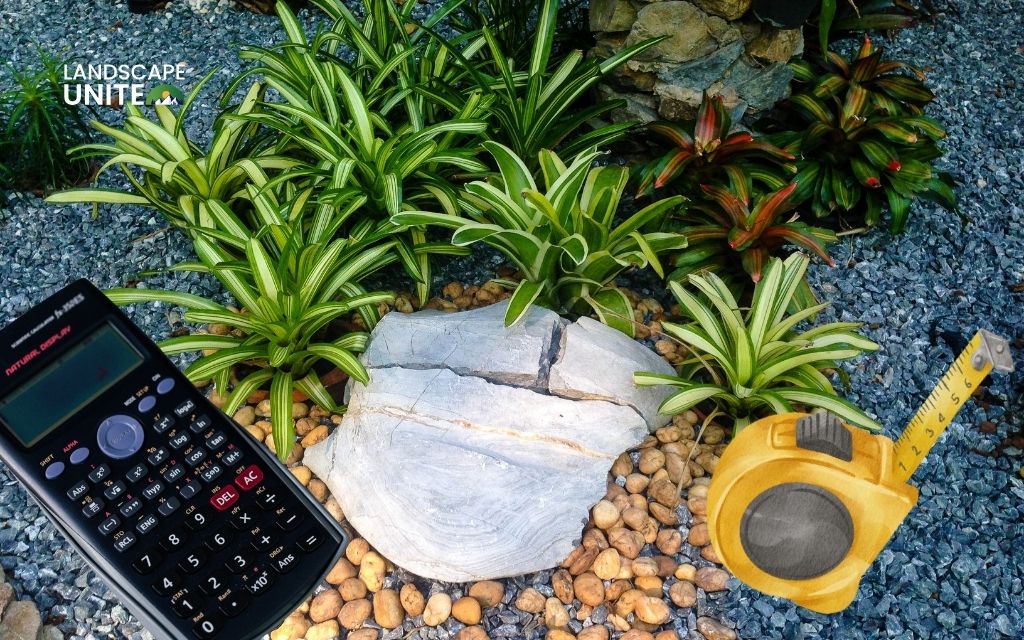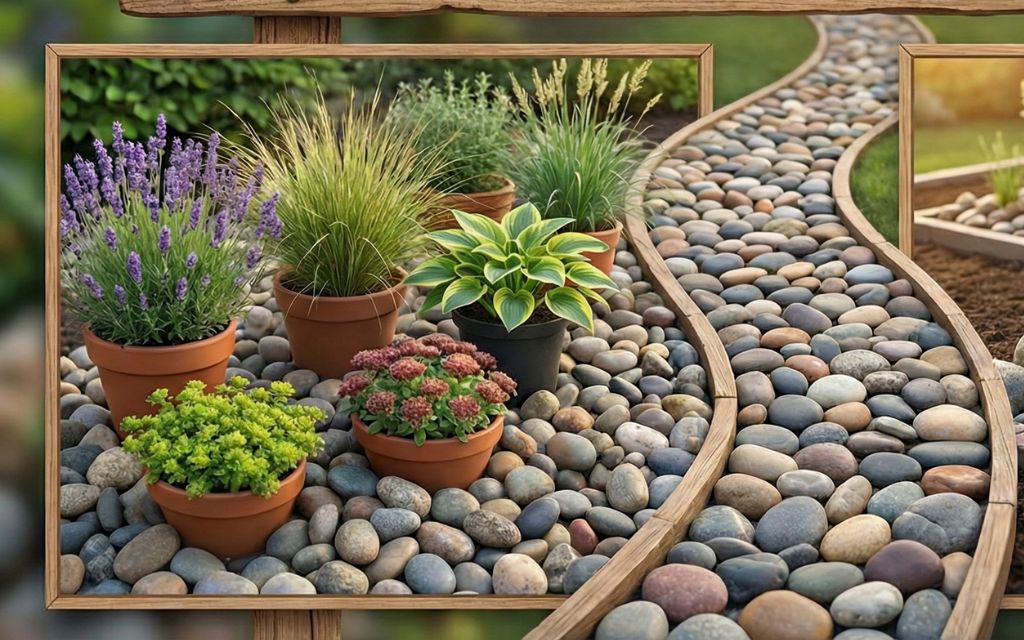What plants are good for xeriscaping? Choosing plants suited to your local climate and soil conditions is the foundation of successful xeriscaping. When you match plants to their natural environment, they require less water, fertilizer, and pest control, creating a sustainable garden that thrives with minimal intervention.
The key lies in understanding your region’s unique growing conditions and selecting plants that have evolved to flourish in those specific circumstances.
Success depends on matching plants to your specific climate and soil conditions rather than fighting against nature. Here are 25 options for different US regions you can consider.
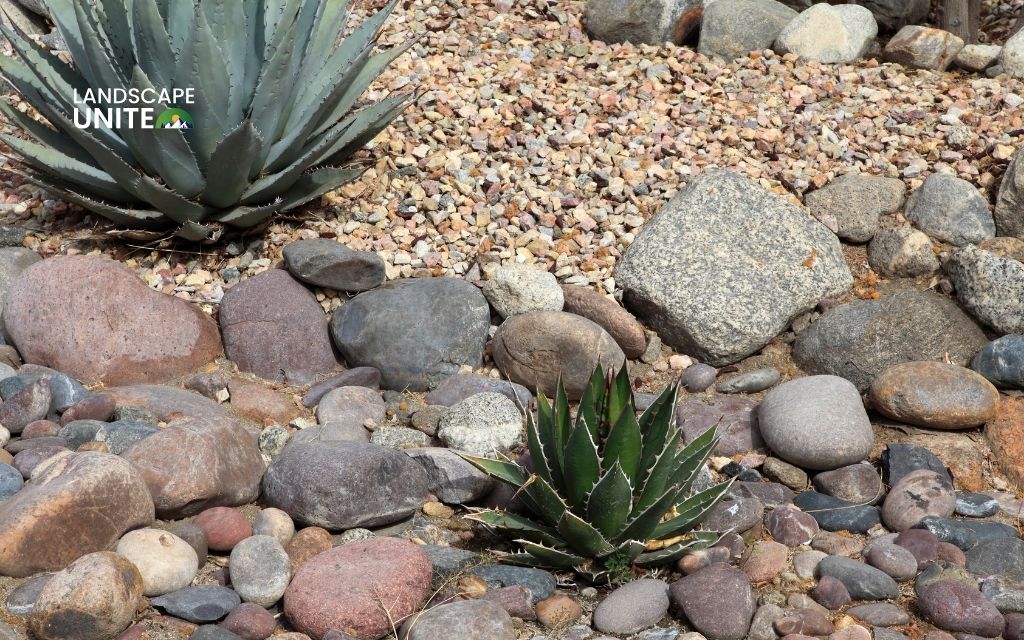
Best plants for xeriscaping in the Southwest U.S.
The desert Southwest offers incredible opportunities for dramatic, water-efficient landscapes. Here are the most reliable drought-tolerant plants for this region:
Agave
Agave stands as the cornerstone of Southwest xeriscaping, offering striking sculptural forms with thick, fleshy leaves that store water efficiently.
These low-maintenance beauties come in various sizes, from compact varieties perfect for containers to massive specimens that serve as stunning focal points. Their spiky silhouettes create dramatic shadows and visual interest throughout the year.
Yucca
Yucca brings hardy adaptability to arid landscapes with sword-like foliage and spectacular flower spikes that attract pollinators.
These versatile plants handle poor soil conditions and extreme heat while providing year-round structure to your garden design.
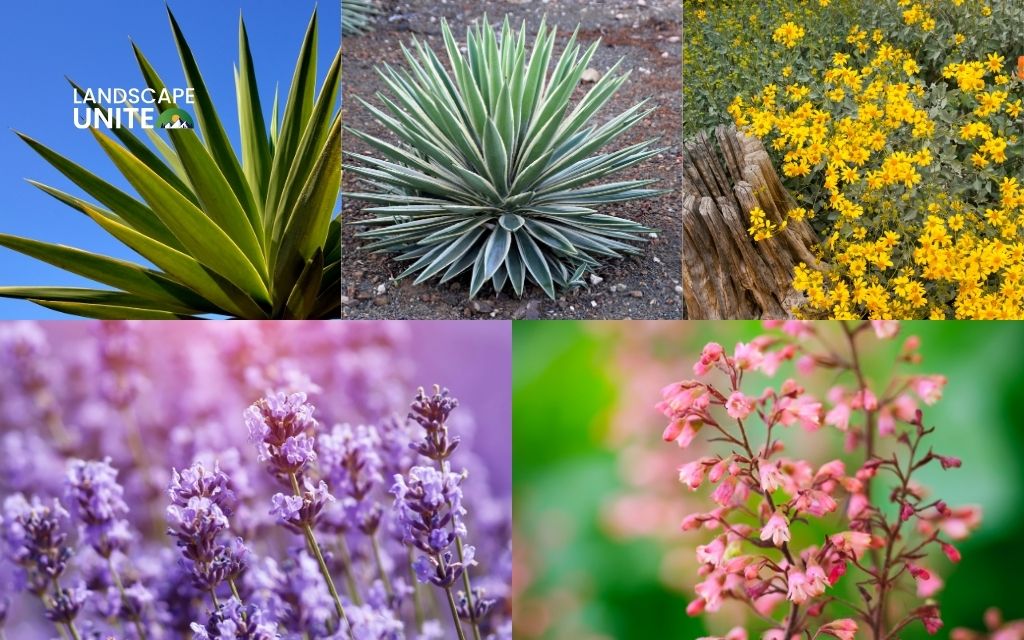
Desert Marigold
Desert Marigold provides cheerful yellow blooms nearly year-round in warm desert climates. These compact perennials self-seed readily, creating natural drifts of color while requiring virtually no supplemental watering once established.
Lavender
Lavender offers the perfect combination of beauty, fragrance, and water efficiency. The silvery foliage and purple flower spikes attract beneficial pollinators while releasing a calming scent that intensifies in hot weather.
Red Yucca
Red Yucca (despite its name, not a true yucca) produces elegant coral-red flower spikes that hummingbirds adore. This clumping perennial blooms from spring through fall and tolerates both drought and occasional moisture.
Best plants for xeriscaping in the West and Rocky Mountains
High-altitude gardening presents unique challenges with temperature extremes and shorter growing seasons. These mountain-hardy plants excel in low-water conditions while handling dramatic weather changes.
Penstemon
Penstemon varieties paint the Rocky Mountain landscape with tubes of vibrant color. These native wildflowers produce spikes of red, pink, purple, or white blooms that attract hummingbirds and butterflies.
Once established, they require minimal supplemental watering and readily self-seed for natural expansion.
Russian Sage
Russian Sage creates ethereal clouds of silver-blue foliage topped with delicate lavender flower spikes. This hardy perennial tolerates poor soils, extreme temperatures, and drought conditions while providing late-season color when many other plants have finished blooming.
Purple Coneflower
Purple Coneflower serves double duty as both a pollinator magnet and a drought-resistant beauty. The distinctive raised centers and drooping petals create textural interest, while the seed heads provide winter food for birds and structural elements in the dormant garden.
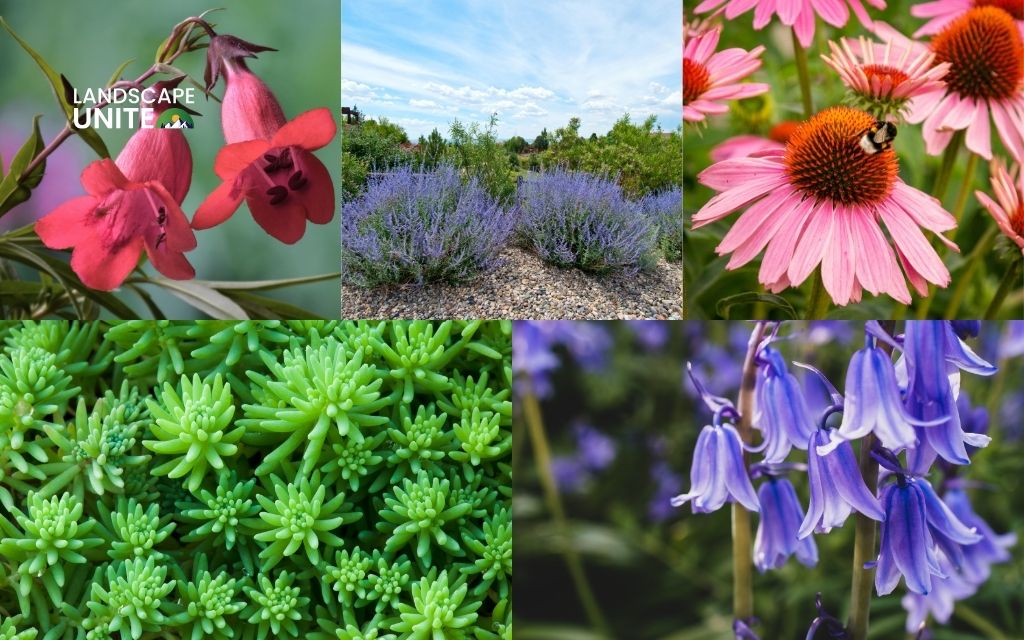
Sedum
Sedum varieties offer incredible diversity in a low-growing package. These succulent groundcovers form dense mats that suppress weeds while storing moisture in their fleshy leaves.
From tiny, bead-like varieties to broader-leafed types, sedums adapt to rocky, challenging sites.
Mountain Bluebell
Mountain Bluebell brings true blue coloring to high-altitude gardens. These delicate-looking natives are surprisingly tough, emerging early in spring and tolerating late frosts while providing crucial early nectar sources for emerging pollinators.
Best plants for xeriscaping in the Pacific Northwest
The Pacific Northwest’s wet winters and dry summers create unique growing conditions that require plants capable of handling feast-or-famine water cycles.
Salvia
Salvia varieties excel in Mediterranean-like conditions with wet winters and dry summers. These hardy perennials produce spikes of tubular flowers in blues, purples, reds, and whites while their aromatic foliage deters deer and rabbits. Many varieties bloom repeatedly throughout the growing season.
Manzanita
Manzanita shrubs epitomize low-maintenance Pacific Northwest gardening. These evergreen natives feature smooth, reddish bark and small, urn-shaped flowers followed by berry-like fruits that birds enjoy. Their dense branching structure provides year-round interest and habitat value.
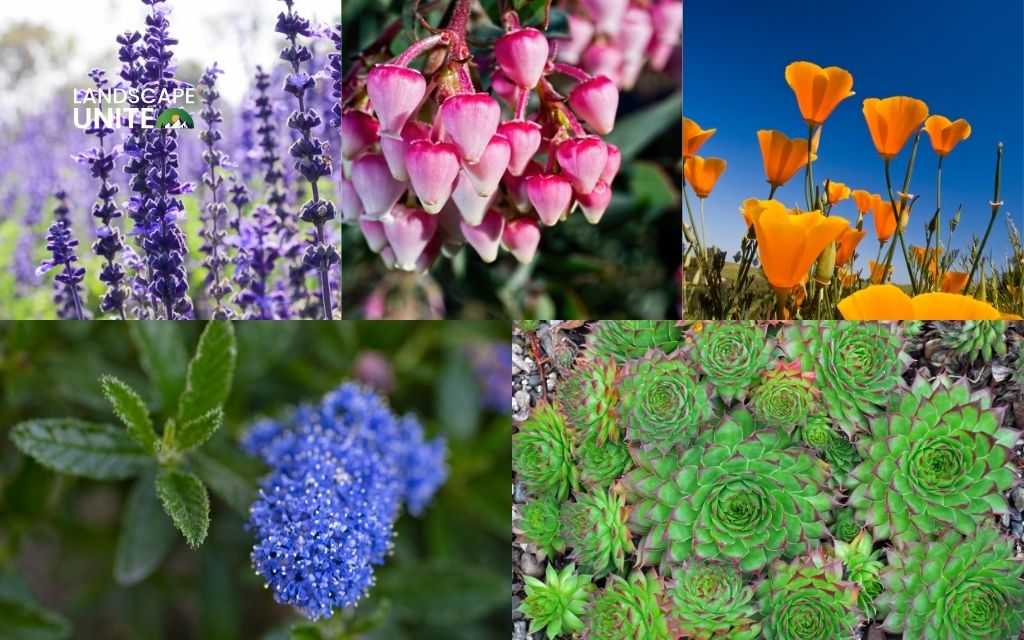
California Poppies
California Poppies carpet the ground with brilliant orange, yellow, or cream-colored blooms.
These annual flowers self-sow readily and close their petals during cloudy weather, conserving energy and moisture. They thrive in poor soils and actually perform better without supplemental fertilization.
Ceanothus
Ceanothus shrubs produce stunning clusters of blue, purple, or white flowers that seem to glow against their evergreen foliage. These nitrogen-fixing plants improve soil conditions while requiring minimal care once established. Their dense growth habit makes them excellent for slopes and erosion control.
Hens-and-Chicks
Hens-and-Chicks succulents create living carpets that spread through underground runners and offsets. These rosette-forming plants store moisture in their fleshy leaves and produce charming flowers on tall stalks. They’re perfect for rock gardens, containers, and difficult sites.
Best plants for xeriscaping in the Southeast U.S.
The Southeast’s humid climate with periodic dry spells requires plants that can handle both moisture extremes while tolerating heat and humidity.
Black-eyed Susan
Black-eyed Susan brightens gardens with cheerful yellow blooms centered with dark “eyes.” These hardy perennials spread gradually to form colonies, providing extended blooming periods and attracting butterflies and beneficial insects. They tolerate both drought and occasional flooding.
Autumn Joy Sedum
Autumn Joy Sedum transitions through multiple color phases, starting with pale green foliage, progressing to pink flower heads, and finishing with russet-red fall color. This long-lasting perennial requires virtually no maintenance while providing three seasons of interest.
Liriope
Liriope creates a dense, grass-like groundcover that tolerates both drought and shade – a rare combination in the plant world. The variegated forms brighten dark areas, while the purple flower spikes add vertical interest. It’s excellent for defining pathways and garden borders.
Daylilies
Daylilies offer incredible diversity in height, color, and bloom time. These hardy perennials store energy in their fleshy roots, allowing them to survive extended dry periods. With thousands of cultivars available, you can create extended blooming sequences throughout the growing season.
Southern Blue Flag Iris
Southern Blue Flag Iris handles the Southeast’s wet-dry cycles with grace. These native iris thrive in areas that are occasionally flooded but can also tolerate extended dry periods.
Their blue flowers provide cool color during hot summers, while their sword-like foliage adds architectural interest.
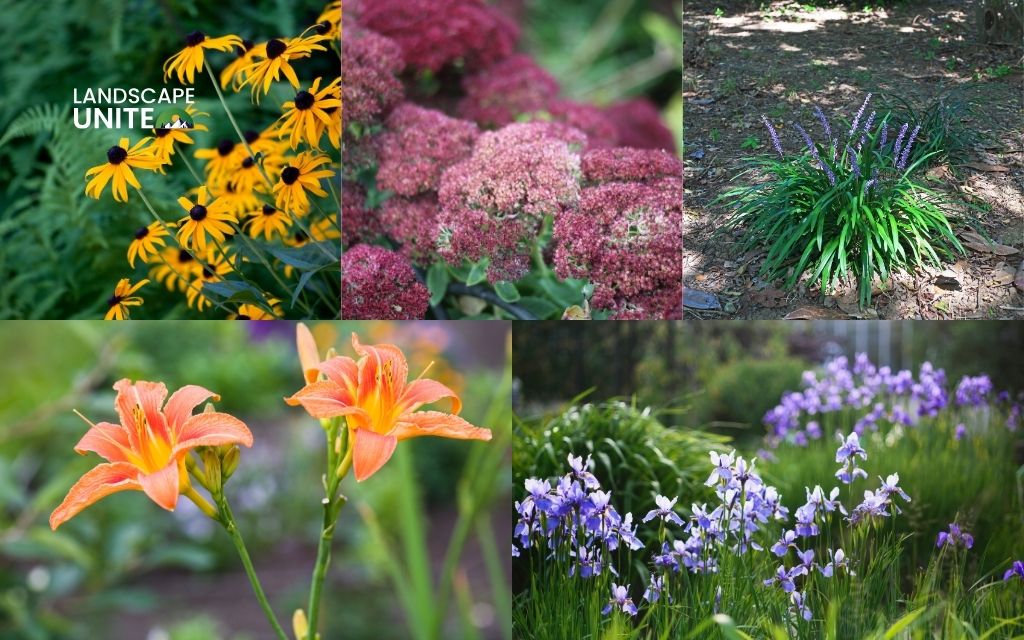
Best plants for xeriscaping in the Midwest and Northeast
Seasonal precipitation fluctuations in these regions require plants that can handle wet springs, potentially dry summers, and cold winters.
Black-eyed Susan
Black-eyed Susan proves its worth across multiple regions, offering reliable drought resistance and extended blooming periods. In the Midwest and Northeast, it provides crucial late-season nectar when many native plants have finished flowering.
Shasta Daisy
Shasta Daisy delivers classic white daisy flowers that brighten gardens throughout summer. These low-maintenance perennials spread gradually through underground runners and require minimal care once established. They’re excellent for cottage gardens and naturalized areas.
Switchgrass
Switchgrass adds movement and texture to xeriscaped gardens. This native prairie grass develops deep root systems that access moisture far below the surface. Its upright growth habit and feathery seed heads provide four-season interest and wildlife habitat.
Coneflower
Coneflower varieties extend beyond the purple species to include yellow, orange, white, and coral-colored options. These easy-to-grow perennials attract pollinators during their blooming period and provide seed for birds throughout winter.
Echinacea
Echinacea encompasses the purple coneflowers while also including the broader range of colors now available through selective breeding. These hardy perennials combine drought tolerance with pollinator support and medicinal properties.
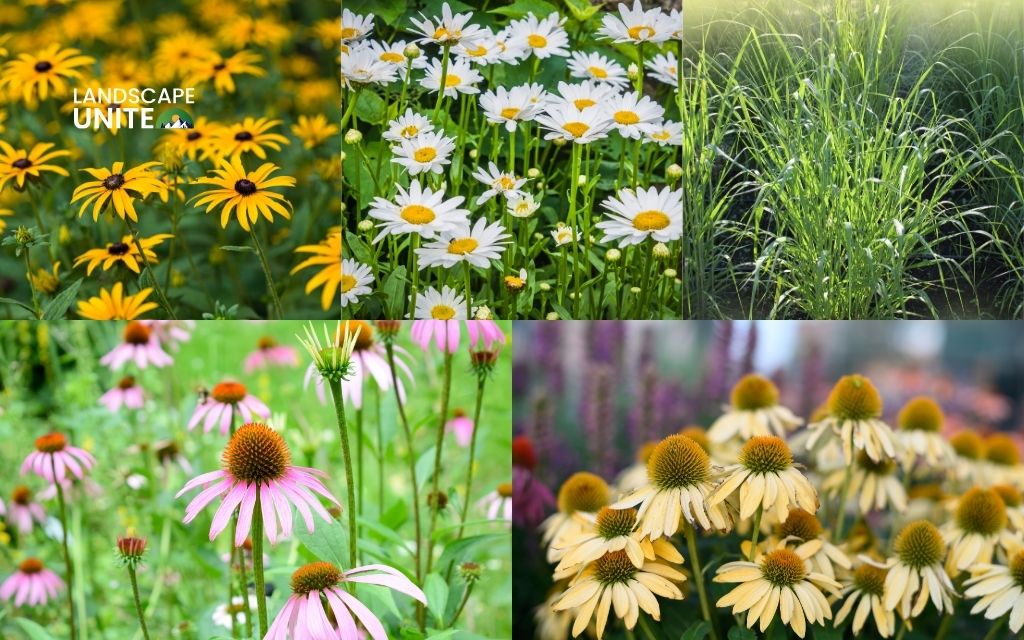
How to care for xeriscaping plants
Watering
Proper watering techniques maximize plant health while minimizing water usage.
Deep, infrequent watering encourages deep root development, making plants more drought-resistant over time.
Install efficient irrigation systems like drip lines that deliver water directly to root zones without waste through evaporation or runoff. These systems can be automated and adjusted seasonally to match changing plant needs and weather patterns.
Soil preparation and fertilization
Prepare soil for xeriscaping plants by improving drainage and adjusting nutrient levels appropriately. Most drought-tolerant plants prefer well-draining soils and can actually be damaged by overly rich, moisture-retentive conditions.
Use organic mulch and compost strategically to retain soil moisture while improving soil structure. Apply mulch around plants but keep it away from plant stems to prevent moisture-related problems and pest issues.
Many xeriscaping plants perform better in lean soils, so avoid over-fertilization which can promote lush growth that requires more water and is more susceptible to pest problems.
Pruning
Implement pruning techniques that maintain plant health, attractive shape, and prevent overgrowth that might shade neighboring plants or block air circulation.
Remove dead plants and excess foliage regularly to maintain proper air circulation and optimize water efficiency. This prevents pest and disease problems while ensuring that irrigation reaches intended plants rather than being intercepted by unnecessary plant material.
Conclusion
Selecting the right xeriscaping plants for your region creates beautiful, sustainable landscapes that conserve water while supporting local ecosystems. By choosing plants adapted to your climate and soil conditions, you’ll enjoy reduced maintenance, lower water bills, and gardens that thrive with minimal intervention.
To enhance your gardening knowledge and create sustainable landscapes, explore more valuable lessons on our outdoor living guides today!
Frequently asked questions (FAQs)
What is the best time of year to plant xeriscaping plants?
The ideal planting time varies by region, but generally, fall planting allows xeriscaping plants to establish strong root systems during cooler weather before facing their first summer stress. Spring planting is also successful in most areas, giving plants a full growing season to establish before winter.
Can I xeriscape if I live in a cold climate?
Absolutely! Cold climate xeriscaping focuses on plants that can handle both winter cold and summer drought periods. Many native prairie plants, alpine species, and cold-hardy succulents thrive in these conditions while requiring minimal supplemental watering.
How do I plan a xeriscape garden for my region?
Start by researching your local climate zone, average rainfall patterns, and soil conditions. Contact your local extension office for plant recommendations specific to your area. Group plants with similar water needs together and choose species that are native or well-adapted to your region’s natural conditions.
Are xeriscaping plants easy to maintain?
Yes, most xeriscaping plants require significantly less maintenance than traditional landscape plants once established. They typically need less watering, fertilizing, and pest management. However, they may require specific soil conditions or pruning techniques to maintain their appearance and health.
